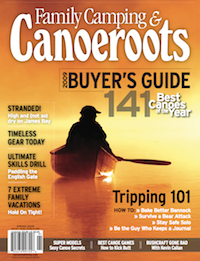Teaching myself to fly fish was like taking myself canoeing before I could tell a Grumman from a cattle trough. I found myself at sea with the paddle upside down.
Before my canoe trip to B.C.’s Bowron Lakes I had borrowed a six-weight travel fly rod and parted with enough money and dignity in a fancy fly shop to walk away with all the other gear I needed to go fishing.
At our first campsite I crouched with my plastic shopping bag of fly shop goodies and my nine-piece rod and cross-referenced all the user manuals and package instructions with a book called What Fly Do I Use. This is how I figured out how to put the rod together, attach the reel to the rod right-side up, clinch-knot the fly to the tippet, measure the tippet and loop-tie tippet to leader, leader to sink tip, and sink tip to fly line.
Untangling a 4x tipper from an alder bush is one way to pass the time while your trip mates cook dinner
Hours later, I had a canoe-length of mostly invisible leader dangling with a hook on the end like a purpose-built weapon for snagging eyeballs. I carefully carried it to a clearing by the water that had recently been evacuated by bystanders, and ventured a cast. I can tell you this. Untangling a 4x tippet from an alder bush is one way to pass time while your trip mates cook dinner. So went day one.
I paddled by day and practiced by night until I cut my set-up time from two hours to 10 minutes. Which left the cast. Nobody on my trip knew how to fly fish, yet half of them thought they knew enough to instruct. One had seen her father fly fish once long ago.
“But doesn’t it go something like this?” she insisted, arm flailing. A park ranger buzzed up in a motorboat to say, “Pretend your elbow is strapped to your body.” She didn’t know how to fly fish either, but had once seen someone teach it.
Annoyed, I walked down the beach to where I could be alone to practice under the guidance of my own soul. Gradually I recalled the cadence that I’d learned during a half-day course last spring, the back-wait-forward-release that would shoot the line a little ways out into the lake—plop.
Halfway around the Bowron Lakes the route descends the Isaac River. An ice-clear mountain stream with deep green pools, the Isaac’s the kind of place where you picture yourself fly fishing even
If you don’t. I raced through the portage and set up my rod. By this time I’d perfected a passable double haul that could zing the fly across 100 feet of river and land it in an eddy with a modicum of grace. When it worked it felt damn good.
I’d like to be able to tell you about the monster trout I caught. On the drive from Vancouver I’d cracked a fortune cookie at the Hong Sheng Restaurant in Williams Lake that read, “The rainbow’s treasures will soon belong to you.” Meaning rainbow trout, I’d thought. Destiny. But so far all it had brought was rain.
The problem was I’d forgotten the names of all the flies I’d bought, the caddises and duns and stone flies and Hendricksons. I’d forgotten which flies were supposed to be sinking flies or floating flies, and which were for rivers or lakes. I chose flies like a rat building a nest, going for colour and bling. But it didn’t matter because arcing my line out onto the Isaac River gave me as much pleasure as any fish. You hungry bystanders and your “Catch us a fish, catch us a fish,” I thought. What do you know? Can’t you see this is my Brad Pitt moment?
On the final night of the trip I started trolling. Fly fishermen call it “streaming.” I’d settled on the only fly whose name I could remember: the woolly bugger. The woolly bugger was a fly I could understand. A fly, the book said, meant to represent nothing and be good for everything. A very non fly-fishermanly fly, that woolly bugger.
I got in the canoe and streamed my soggy, last-ditch woolly bugger around in the dark. Then I felt a flurry of tugs and the tip of my rod danced. My hands shook as I reached for the net and almost dumped the canoe. Everyone on Swan Lake knew I’d caught a fish from the clatter of my paddle and the burst of camera flash like a meteoroid in the night.
After the photo, I carefully slid the wriggling creature back into the water. Be free, you eater of woolly buggers. You not-a-rainbow-trout.
It was not a fortune-cookie’s promise come true. But arriving at its rightful place on my learning curve, the tiny fish gasped a promise of its own. Your success can only improve.

This article first appeared in the Spring 2009 issue of Canoeroots Magazine.



